Chapter: Artificial Intelligence
Types of Transition Network
TYPES OF TRANSITION NETWORK
There are generally two types of transition networks like
1.
Recursive Transition networks
(RTN)
2.
Augmented Transition networks
(ATN)
Let us focus on these two transition networks and their structure for
parsing a sentence.
1. Recursive Transition Networks
(RTN)
RTNs are considered as development for finite state automata with some
essential conditions to take the recursive complexion for some definitions in
consideration. A recursive transition network consists of nodes (states) and
labeled arcs (transitions). It permits arc labels to refer to other networks
and they in turn may refer back to the referring network rather than just
permitting word categories. It is a modified version of transition network. It
allows arc labels that refer to other networks rather than word category. A
recursive transition network can have 5 types of arcs (Allen’s, JM’s) like
1)
CAT: Current word must belong to
category.
2)
WORD: Current word must match label
exactly.
3)
PUSH: Named network must be
successfully traversed.
4)
JUMP: Can always be traversed.
5)
POP: Can always be traversed and
indicates that input string has been accepted by the network. In RTN, one state is specified as a
start state. A string is accepted by an RTN if a POP arc is reached and all the
input has been consumed. Let us consider a sentence “The stone was dark black”.
Here The: ART
Stone: ADJ NOUN
Was: VERB
Dark: ADJ
Black: ADJ NOUN
The RTN structure is given in figure
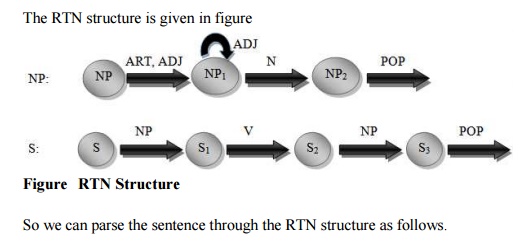
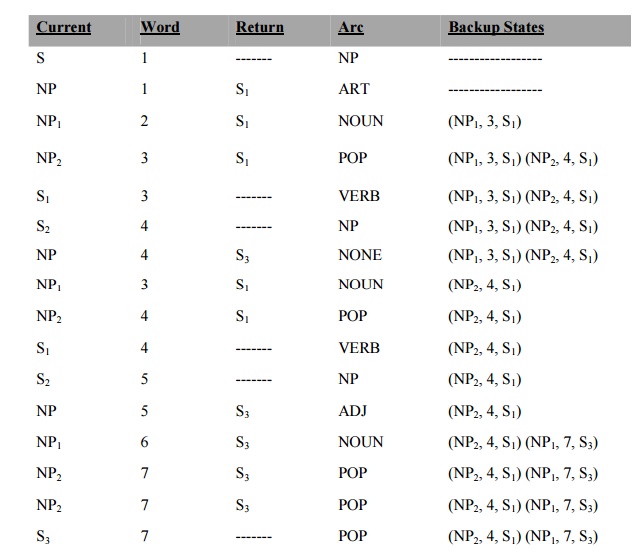
Finally as there are no words left so the parse is successful.
Also there is an another structure of RTN is described by William Woods
(1970) is illustrated in figure. He described the total RTN structure into
three parts like sentence (S), Noun Phrase (NP), Preposition Phrase (PP).
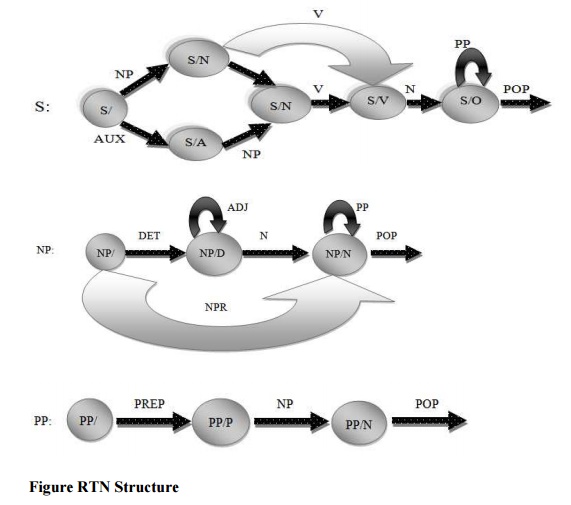
The number of sentences accepted by an RTN can be extended if
backtracking is permitted when a failure occurs. This requires that states
having alternative transitions be remembered until the parse progresses past
possible failure points. In this way, if a failure occurs at some point, the
interpreter can backtrack and try alternative paths. The disadvantage with this
approach is that parts of a sentence may be parsed more than time resulting in
excessive computations. During the traversal of an RTN, a record must be
maintained of the word position in the input sentence and the current state and
return nodes to be used as return points when control has been transformed to a
lower level network.
2. Augmented Transition Network
(ATN)
An ATN is a modified transition network. It is an extension of RTN. The
ATN uses a top down parsing procedure to gather various types of information to
be later used for understanding system. It produces the data structure suitable
for further processing and capable of storing semantic details. An augmented
transition network (ATN) is a recursive transition network that can perform
tests and take actions during arc transitions. An ATN uses a set of registers
to store information. A set of actions is defined for each arc and the actions
can look at and modify the registers. An arc may have a test associated with
it. The arc is traversed (and its action) is taken only if the test succeeds.
When a lexical arc is traversed, it is put in a special variable (*) that keeps
track of the current word. The ATN was first used in LUNAR system. In ATN, the
arc can have a further arbitrary test and an arbitrary action. The structure of
ATN is illustrated in figure. Like RTN, the structure of ATN is also consisting
of the substructures of S, NP and PP.
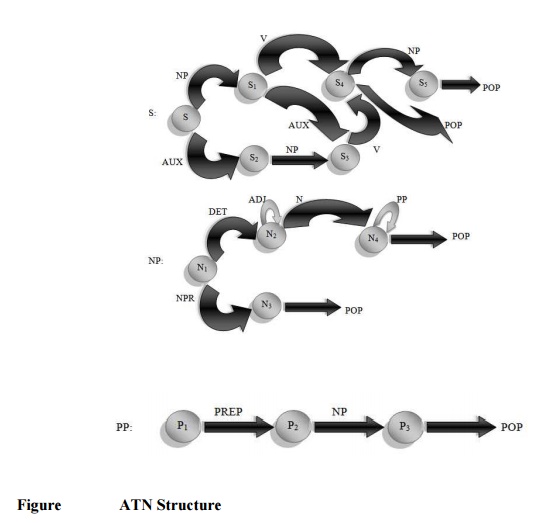
The ATN collects the sentence features for further analysis. The
additional features that can be captured by the ATN are; subject NP, the object
NP, the subject verb agreement, the declarative or interrogative mood, tense
and so on. So we can conclude that ATN requires some more analysis steps
compared to that of RTN. If these extra analysis tests are not performed, then
there must some ambiguity in ATN. The ATN represents sentence structure by
using a slot filter representation, which reflects more of the functional role
of phrases in a sentence. For example, one noun phrase may be identified as
“subject” (SUBJ) and another as the “object” of the verb. Wit hin noun phrases,
parsing will also identify the determiner structure, adjectives, the noun etc.
For the sentence “Ram ate an apple”, we can represent as in figure.
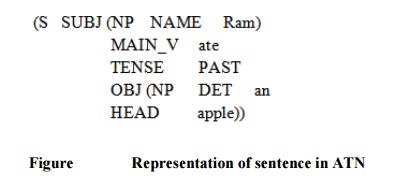
The ATN maintains the information by having various registers like DET,
ADJ and HEAD etc. Registers are set by actions that can be specified on the
arcs. When the arc is followed, the specified action associated with it is
executed. An ATN can recognize any language that a general purpose computer can
recognize. The ATNs have been used successfully in a number of natural language
systems as well as front ends for databases and expert systems.
Related Topics